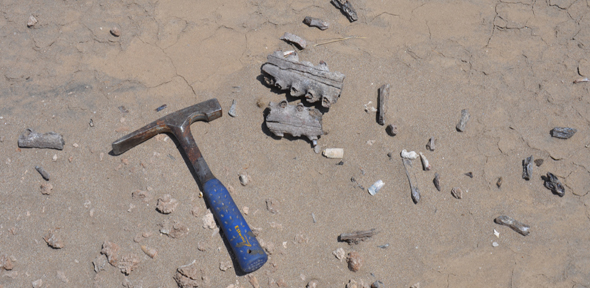
Our research combines specimen-based analyses from museum collections with field research in South America, eastern Africa and South Asia to infer evolutionary and ecological histories of vertebrates from the fossil record. Research topics span the last 380 million years and incorporate anatomical, environmental, and developmental datasets.
Current research topics include:
- The evolution of vertebrate body forms, focusing on the axial skeleton across the clade, anatomical innovations in the origin and early evolution of tetrapods, and crown mammal anatomy.
- The evolution of modern vertebrate clades, focusing on the relationship between fauna and environment in the Paleogene and Neogene tropics.
- Functional trait-environmental relationships in the fossil record and potential applications to modern conservation decisions.
- The evolution of squamate reptiles, especially the origin and diversification of snakes.
Key Publications
Head, J. J., A. F. C. Howard, and J. Müller. In Press. The first 80 million years of snake evolution: The Mesozoic fossil record of snakes and its implications for origin hypotheses, biogeography, and mass extinction. In D. Gower & H. Zaher (eds.). The Origin and Early Evolutionary History of Snakes. Cambridge University Press.
Criswell, K.E., L. E. Roberts, E. T. Koo, J. J. Head, and J. A. Gillis. 2022. hox gene expression predicts tetrapod-like axial regionalization in the skate, Leucoraja erinacea. Proceedings of the National Academy of Sciences, U.S.A. 118(51). doi.org/10.1073/pnas.2114563118
Head, J. J. 2021. A South American snake lineage from the Eocene Greenhouse of North America and a reappraisal of the fossil record of “anilioid” snakes. Geobios. doi.org/10.1016/j.geobios.2020.09.005
Head, J. J., and J. Müller. 2020. Squamate reptiles from Kanapoi: Faunal evidence for hominin paleoenvironments. Journal of Human Evolution. 140, 102451. doi.org/10.1016/j.jhevol.2018.01.007.
Westphal, N., K. Mahlow, J. J. Head, and J. Müller. 2019. Pectoral myology of limb-reduced worm lizards (Squamata, Amphisbaenia) suggests decoupling of the musculoskeletal system during the evolution of body elongation. BMC evolutionary biology, 19(1). doi.org/10.1186/s12862-018-1303-1.
Jones, K. E., K. D. Angielczyk, P. D. Polly, J. J. Head, V. Fernandez, J.K., Lungmus, S. Tulga, and S.E. Pierce. 2018. Fossils reveal the complex evolutionary history of the mammalian regionalized spine. Science. doi: 10.1126/science.aar3126.
Barnosky, A. D., E. A. Hadly, P. Gonzalez, J. J. Head, et al. 2017. Merging paleobiology with conservation biology to guide the future of terrestrial ecosystems. Science, 355 (6325). doi: 10.1126/science.aah4787
Head, J. J., and P. D. Polly. 2015. Evolution of the snake body form reveals homoplasy in amniote Hox gene function. Nature, 520:86-89. doi: 10.1038/nature14042.
P. D. Polly, and J. J. Head. 2015. Measuring Earth-Life Transitions: Ecometric analysis of functional traits from Late Cenozoic Vertebrates. The Paleontological Society Papers, 21: 21-46.
Full publication list via Google Scholar
